10 Core Stability Exercises to Improve Movement Skills in Autism
Many children on the Autistic Spectrum have movement coordination difficulties.
Our child might be labelled as “clumsy”, bump into people/objects, drape themselves over furniture, and tire quickly when holding body positions such as sitting.
Often, the reason for this can be a musculature weakness of the core – the muscles in their back and abdominals – which impacts on balance and posture.
As a result, our child may tire quickly when trying to hold a position and we may notice that they move constantly, fidget and prop their head up when at the table.
Our child might also struggle to use a scooter or ride a bike as a strong core is required.
The core also impacts fine motor skills such as using cutlery, handwriting and cutting with scissors. If our midsection isn’t strong, it is very difficult for our arms, hands and fingers to work in a coordinated fashion.
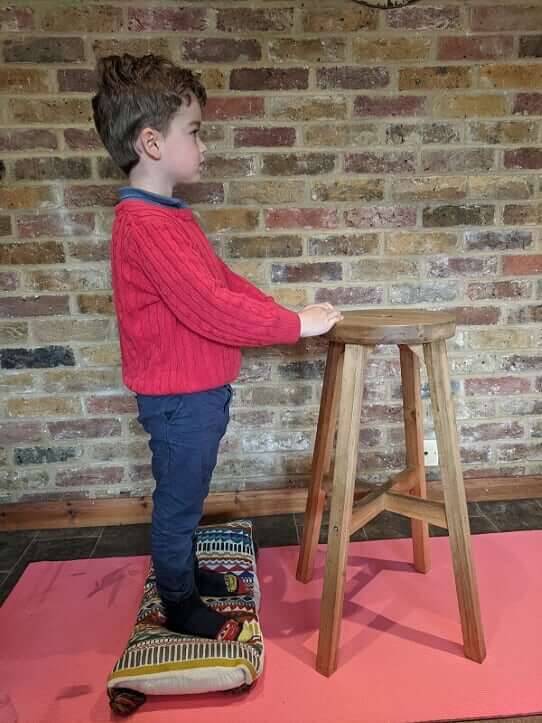
A good core allows us to balance in different positions. It enables us to stay still and balanced while our arms and legs work (e.g. walking) or to stay upright when we are on a moving surface (e.g. a bus). Our bodies are constantly seeking balance so having a good core allows our child to concentrate better as they are able to stay still.
The added benefit of working on the core muscles is that the weight-bearing exercises involve deep pressure, which not only increase body awareness but also provide calming proprioceptive input. You may find that after engaging in 5-10 minutes of these activities, your child shows an increased ability to focus and attend to a task.
-
Below we share some core stability exercises to work through with your child. Go down the list and find the first level that they would find a little difficult. This is your starting point. Enjoy that activity until they can manage it well. If they can’t manage a certain activity, move them back a section or move onto the next section. You can be practicing several activities in the same session to be more effective.
-
Make sure your child is successful in their game as this will motivate them to continue. As you push them to get to the next level, they should be able to manage a few of their attempts to keep motivated – even if they are not successful at all of them.
-
Remember to praise the effort made rather than the result achieved. This will motivate your child to persevere with an activity and not be put off if they don’t succeed at first.
Here are some fun and exciting activities to try at home to improve your child's core stability
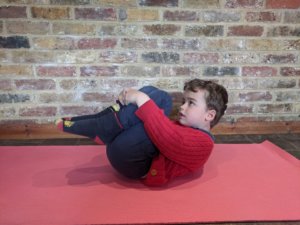
-
Your child lies on their back and lifts their legs to their chest and holds on to their knees with their arms. See if they can lift their head and hold up to 20 seconds in the ball shape without rolling over or dropping their head
-
Try playing with a ball in this position – keep their knees up but hold a ball behind their head and then throw it towards their feet. The adult can then hold the ball above the child’s feet for the child to come and pick it up again.
-
In the same position, throw a ball in the air and the child needs to kick the ball up in the air back towards you with both feet.
-
Lie on your back in a sit-up position with knees bent and try rolling a ball with two hands up the thighs and over the knees.
Lie your child flat on their tummy with their arms up in front of them and their legs straight behind them. They should then try to lift their straight arms and head up off the floor and hold for 20 seconds.
Next try to lift their arms and their legs up and hold for 20 seconds.
They could roll a ball back and forward out in front of them from this position as a rolling game or to knock down some skittles.
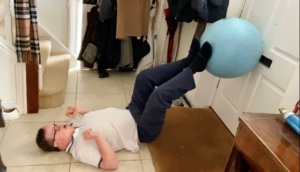
Your child should lie on their back with their feet on a gym/physio ball (or on a cushion if there is no ball available) against the wall. Move the cushion/ ball up and down the wall and then side to side. Try drawing a picture or writing their name.
Lying on their back with their feet on the ball. The child should try to keep the ball still while you try to move it side to side.
Lie your child on their back with their knees bent and their feet either on the floor or on your lap. Encourage them to lift their bottom up and try and hold it up for 20 seconds. You can try to drive some cars or other toys under their bottom to help encourage them to hold it up. They can also try to hold a ball between their knees while they do this.
Lie your child on their back with their knees bent and their feet either on the floor or on your lap. Encourage them to lift one leg in the air with a straight knee or crossed over the other leg. Now lift their bottom and ask them to try to keep their bottom up for 20 seconds with their hips staying level.

Lie your child on their back with their knees bent and one leg up. Lift their bottom and try lowering their straight leg down and up again. (The straight leg shouldn’t go lower than the knee on their other leg).
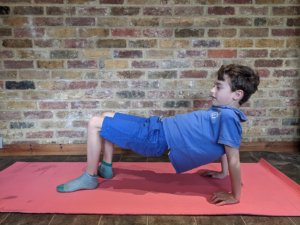
Sat on the floor and with their hands out behind them, facing their feet and with their knees bent (feet on the floor). Encourage your child to lift their bottom up and hold it so they make the shape of a table.
Try walking around like this.
Make it more challenging by balancing a toy or even a ball on their tummy while they walk around in all directions.
They could pretend to be different animals and make a game of it – try being a snake on the floor, or bear walk on hands and feet, or kangaroo jumps. Make an obstacle course and challenge your child to complete it as different animals.
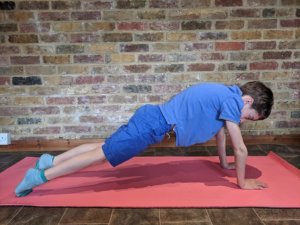
Get your child to lie on their tummy and put their hands at chest level. Help them to push up so that their weight is just on their hands and their toes. Get them to hold this position for as long as they can. Make sure their bottom isn’t up in the air but that you also aren’t letting their tummy sag down. Drive some cars under them to encourage the child to keep it up.
Do this facing a sibling and try clapping one of their hands to one of your hands. See how many claps your child can do – try to get to 20 claps.
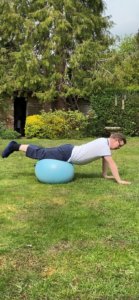
These should be done with help from an adult to make sure you child is safe.
Your child should sit on a gym ball with their feet on the floor. They should try and balance while they move their bottom around. If your child struggles to balance on the round gym ball, try using a peanut-shaped stability ball, which has a dip in the middle. They can sit astride it when participating in various games/activities.
Try to lift one foot off the floor and keep balancing.
Try to lift both feet off the floor.
Roll your child over the ball on their tummy until their hands reach the floor. Keep walking them forward on their hands until only their feet are still on the ball. Reach for objects in this position.
Walk backwards until they are fully back on the ball. You can make this more interesting by encouraging them to pick up puzzle pieces and doing a puzzle or by picking up beanbags to throw into a bucket.
Lie your child on their back on the gym ball. Hold your child’s feet as they reach for an object on the floor behind the ball. Ask them to bring the object back up to throw into a container for an extreme sit up. Make sure they tuck their chin onto their chest when lifting head and shoulders.
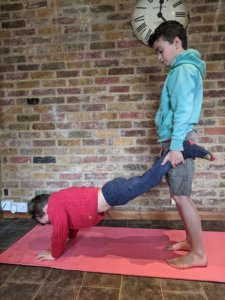
Hold your child by their hips with their legs straddling you and their hands on the floor. Move around the floor with your child walking on their hands, picking up objects for as far as they can go.
Move your hands down to your child’s knees and walk around the room – picking up objects or playing a matching game or skittles.
If you can, hold your child by their ankles. Make sure they keep their bottom in the air and don’t hang their tummy down. Again find a game to make this more entertaining.
As your child gets stronger you could try to get from one end of the house to another – even trying going up the stairs.
You could also make an obstacle course to go around.
On their hands and knees – reach one arm straight out in front of them in the air – you can challenge them to balance a beanbag or soft toy on the back of their hand to keep it up. Try and hold for one minute.

Now try and lift one leg straight out behind them. Try and hold this for one minute.
Can they do an opposite arm and leg at the same time and hold it for one minute?
Try the other side.
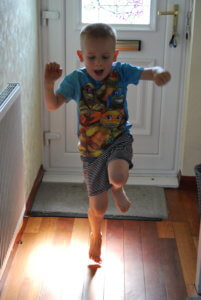
-
Try standing on one leg with a foot on a ball. Can you move the ball around in circles or up and down?
-
Now try standing on one leg with one foot in the air.
-
Can you still do this while throwing a ball in the air?
-
Now try to stand on a wobble cushion (a cushion with air in it) or just a small well-stuffed pillow.
-
Can you do this on one leg?
-
And while throwing and catching?
-
How about on one leg and picking up a ball from the floor to play with skittles or target practice?






